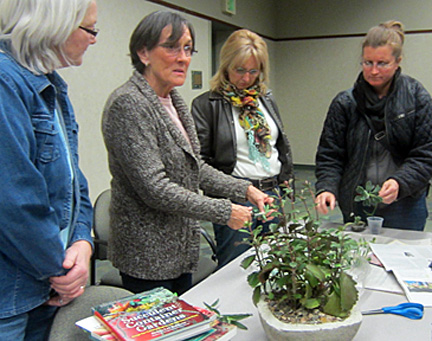
Jan Bower (second from left) demonstrates how to propagate succulent plants to some members of the Succulent Society of the Ozarks. Members were able to take home cuttings to create their own plants.
Jan Bower said she has been a teacher. She also established a legal nurse consultant business. But what has held her passion since her retirement three years ago is her research into the growing and care of succulents. "Basic Succulent Care" is the topic of a talk she gave at the March meeting of the Succulent Society of the Ozarks held at the Library Center in Springfield.
Her attraction to the plants grew after a visit to a Spring Planting Festival at the Baker Creek Seed Company in Mansfield, Missouri. She said she had brought home "cute little things," but didn't even know that they were succulents. But with her background in research and finding books on the subject at book sales, she became more knowledgeable.
A visit out West, she said, with its maritime climate, revealed how easy it was to maintain succulents, but she realized that growing them in Missouri would not be without challenges.
She decided first to learn how to prepare her own soil. While Bower said that succulent gardeners without concern for expense could use Miracle Grow's Cactus, Palm and Citrus Soil for their plantings, she preferred making her own out of equal parts of soil (basic potting mix - not moisture control), sand (play sand) and perlite (coarse pumice/vermiculite). She said she uses more pumice for fatter leaved succulents (Euphorbias) that hold their own water, more soil and less pumice for plants with delicate leaves that dry out quicker and a mixture of half pumice and half soil in creating a mix of plants in one pot.
"A good consistency for the soil is when water applied to it can be squeezed out," Bower said.
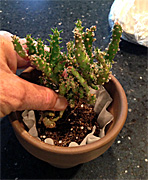 In planting a succulent, a coffee filter is used to keep the soil in the pot. In planting a succulent, a coffee filter is used to keep the soil in the pot.
Starting with a clean pot made of clay with a hole in the bottom for drainage (she bought drill bits to create holes not there), Bower inserts a coffee filter to keep the soil in the pot or keep the roots in.
And does the pot need to be filled with soil? No, said Bower. She fills a plastic bag with peanuts to take up the space not needed for the plants that have shallow roots.
Holding the plant with its roots loose in the pot, with the base of the plant level with the top of the pot and keeping the plant straight, she loosely covers the roots and base of the plant with soil, then top dresses the pot with rocks for moisture control and plant protection.
"Don't use limestone," Bower said. "It changes the Ph level."
Propagation of pups
The first step is to shake soil from the mother plant and her pup and then inspect the roots for bugs. See how the babies are connected, Bower warned, to make sure they are separated with a root system.
"It's so much fun to take the babies off," Bower exclaimed.
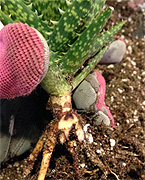 Inspect the roots of the plant for transplanting. They should look hearty and be free of bugs. Inspect the roots of the plant for transplanting. They should look hearty and be free of bugs.
Then the babies and mom are replanted using the same method as originally used, but making sure the pots used are cleaned with bleach and a little lemon juice, both on the outside of the pot and inside.
Propagation of stem cuttings, leaf cuttings and leggy plants
Bower creates a nursery for those plants she is attempting to grow from leaf or stem cuttings. She twists or cuts off a healthy looking leaf and then carefully lays it on the soil.
"Don't water it for a couple of weeks after laying the leaf on the soil," Bower warned. "It will start producing roots."
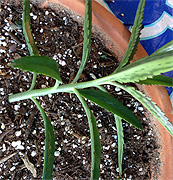 A cutting from a Kalanchoe is carefully laid on the soil so that it can start producing roots. A cutting from a Kalanchoe is carefully laid on the soil so that it can start producing roots.
For propagating Kalanchoe or alligator tongue, Bower mentally divides the plant's stem into thirds. Then she cuts the top third above a pair of healthy leaves using a sharp knife and lays this piece on the soil to start producing roots.
"Do not water it," she again stressed.
On the subject of water, Bower suggested using a water meter and water the plants when that meter reads at "1" (top inch of soil feels dry); water until the flow exits the hole of the pot. Plants should be watered from March until October using a long spouted watering can so as not to get water on the leaves, she said.
Fertilizing
Plants should be fertilized every 10-14 days during the growing months, April through September. Bower recommended using 20-20-20 fertilizer.
That's nitrogen for growth and hardiness, phosphorus for roots and height and potassium to work with the nitrogen, she explained.
Transitioning to the outside
"Thank goodness, we only have to do this twice per year," Bower exclaimed, telling everyone that it is not done in a day. "Transitioning is the biggest pain," she said.
She explained that the plants are finicky. Some require full sun, part shade or protection from the elements. They may prefer to be on a porch or under a tree getting afternoon shade.
Bowers said she moves her plants outdoors afer all chance of frost is gone, perhaps, after Mother's Day. She does this transition in three stages: Stage 1 requires keeping the plants for three days in a protected area like a screen porch; stage 2 allows the plant to be in a more sunny location for a day or two but brought in at night; and in stage 3 the plant is at its final destination.
Thank goodness, you say?
"Am I crazy? Bowers asked. "Probably so," was her own reply. But then she showed the gorgeous flowers her alligator tongue plant produced.
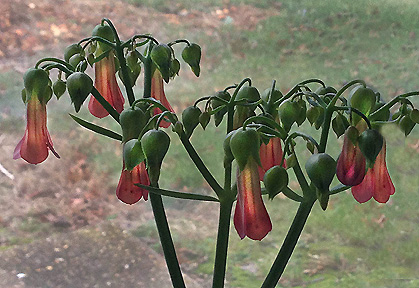
The Kalanchoe plant in bloom
Go Back | 






